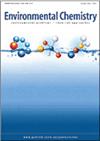Investigation of diffusion and binding properties of uranium in the diffusive gradients in thin-films technique
IF 2.3
4区 环境科学与生态学
Q3 CHEMISTRY, ANALYTICAL
引用次数: 1
Abstract
Environmental context Monitoring uranium concentrations and speciation in aquatic systems is important for pollution control and for environmental studies. Although an in situ speciation technique based on diffusion and uptake of uranium has been developed, known as DGT, there were uncertainties over some parameters affecting the accuracy of the measurements. This study resolved those uncertainties by investigating diffusion and binding properties of uranium in DGT and provided confidence in monitoring uranium in the environment. Rationale Diffusive gradients in thin-films (DGT) ha been used for uranium speciation measurements since 2006, but interpretational difficulties have arisen due to uncertainties in the pH dependence of U diffusion coefficients (D) within the diffusive gel. This work tested the hypothesis that differences in measured D values between laboratories are due to methodological artifacts. Methodology The properties of uranium binding and diffusion of U within DGT were systematically investigated at different conditions between pH 3–8 and ionic strength from 1 to 500 mmol L−1. Previous uncertainties were attributed to loss of U by adsorption within the diffusion cell, identified by mass balance calculations, and a binding efficiency dependent on the type of binding gel. Results The diffusion coefficient in an agarose cross-linked polyacrylamide gel measured using Metsorb DGT of 5.26 ± 0.17 × 10−6 cm2 s−1 agreed well with both values obtained using a pre-conditioned diffusion cell (< 7% difference) and by modelling. The binding efficiencies for Chelex DGT (BChelex = 0.86–0.89) and Fe-oxide DGT (BFe-oxide = 0.64 were smaller than for Metsorb DGT (BMetsorb = 1). No significant differences were found for BChelex at different pH. Discussion This work demonstrated that the diffusion coefficient of uranium is independent of pH and the binding gel used, provided the binding efficiency (B) is taken into account. These findings indicate that DGT equipped with either Metsorb or Chelex binding gels should be capable of measuring U for a wide range of environmental conditions provided the appropriate diffusion coefficients and binding efficiencies are used.铀在薄膜扩散梯度中的扩散与结合特性研究
监测水生系统中的铀浓度和铀物种形成对污染控制和环境研究很重要。虽然已经发展了一种以铀的扩散和吸收为基础的原位物种形成技术,称为DGT,但影响测量精度的一些参数存在不确定性。本研究通过研究铀在DGT中的扩散和结合特性解决了这些不确定性,并为监测环境中的铀提供了信心。自2006年以来,薄膜中的扩散梯度(DGT)已被用于铀形态测量,但由于扩散凝胶中U扩散系数(D)的pH依赖性的不确定性,导致解释困难。这项工作验证了一个假设,即实验室之间测量D值的差异是由于方法上的人为因素造成的。方法系统研究了在pH 3 ~ 8、离子强度1 ~ 500 mmol L−1的不同条件下,铀在DGT中的结合和扩散特性。先前的不确定性归因于扩散池内吸附U的损失,通过质量平衡计算确定,以及依赖于结合凝胶类型的结合效率。结果用Metsorb DGT测定的琼脂糖交联聚丙烯酰胺凝胶的扩散系数为5.26±0.17 × 10−6 cm2 s−1,与用预调节扩散池测定的值(差异< 7%)和模型计算的值吻合良好。Chelex DGT (BChelex = 0.86 ~ 0.89)和Fe-oxide DGT (BFe-oxide = 0.64)的结合效率均小于Metsorb DGT (BMetsorb = 1)。研究表明,考虑到结合效率(B),铀的扩散系数与pH和所使用的结合凝胶无关。这些发现表明,只要使用适当的扩散系数和结合效率,配备Metsorb或Chelex结合凝胶的DGT应该能够在广泛的环境条件下测量U。
本文章由计算机程序翻译,如有差异,请以英文原文为准。
求助全文
约1分钟内获得全文
求助全文
来源期刊

Environmental Chemistry
环境科学-分析化学
CiteScore
4.50
自引率
0.00%
发文量
0
审稿时长
2.7 months
期刊介绍:
Environmental Chemistry publishes manuscripts addressing the chemistry of the environment (air, water, earth, and biota), including the behaviour and impacts of contaminants and other anthropogenic disturbances. The scope encompasses atmospheric chemistry, geochemistry and biogeochemistry, climate change, marine and freshwater chemistry, polar chemistry, fire chemistry, soil and sediment chemistry, and chemical aspects of ecotoxicology. Papers that take an interdisciplinary approach, while advancing our understanding of the linkages between chemistry and physical or biological processes, are particularly encouraged.
While focusing on the publication of important original research and timely reviews, the journal also publishes essays and opinion pieces on issues of importance to environmental scientists, such as policy and funding.
Papers should be written in a style that is accessible to those outside the field, as the readership will include - in addition to chemists - biologists, toxicologists, soil scientists, and workers from government and industrial institutions. All manuscripts are rigorously peer-reviewed and professionally copy-edited.
Environmental Chemistry is published with the endorsement of the Commonwealth Scientific and Industrial Research Organisation (CSIRO) and the Australian Academy of Science.
 求助内容:
求助内容: 应助结果提醒方式:
应助结果提醒方式:


